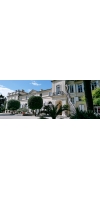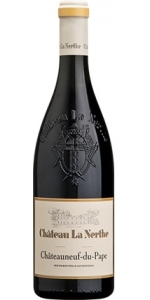Wine from La Nerthe

Wine grapes have been grown at the estate since the 1500s, making it one of the oldest estates in Châteauneuf-du-Pape.
- Exceptional, sloped terroir with soils of sandy-clay and a layer of large, round, well-worn galet stones
- All the terroirs of Châteauneuf-du-Pape in a single estate
- All 13 of the permitted primary varietals are planted
- Average vine age over 40 years old
- Certified AB Organic since 1998
- A veteran, acclaimed winemaking team and a rich, unique history
Château La Nerthe is in contention for being one of the oldest estates in Châteauneuf-du-Pape. The estate was first purchased by the Tulle de Villefranche family in 1560. The historic Château was built in 1736. Château La Nerthe deserves credit for being one of the first estates to bottle their own wine. This took place to some extent starting in 1784. Château La Nerthe is one of the first, if not the first estate in Châteauneuf-du-Pape to export their wine outside of France. Another first that belongs to the estate is that Château La Nerthe began the practice of destemming 100% of their vines in the 1800’s. By this point in time, Château La Nerthe was the most expensive wine from the Southern Rhône.
In 1870, the Tulle de Villefranche family sold the property to the Joseph Ducos family. The sale took place in part, because of the devastation caused to the vineyards by Phylloxera. The Ducos family made their mark on Chateau la Nerthe’s history by replanting the vineyard on grafted phylloxera rootstock and by planting new, local grape varieties; 10 of the 13 permitted varietals were planted. The Ducos family maintained ownership of the property until 1941 when Château La Nerthe was bought at an auction by the Leclerc and Motte families.
By 1985, Château La Nerthe had become dilapidated and was put up for sale by the Dereumaux family and purchased by the Richard family in partnership with David and Foillard negociants. Their goal for the estate was to revive the original values of excellence and innovation. A complete renovation of the estate took place and much of the vineyards were replanted. In 1991, Château La Nerthe was able to expand their holdings with the purchase of 54 acres of vines, which helped to create one of the largest estates in the Southern Rhône with 230 acres. In 1998, the vineyard is certified organic. Rémi Jean joined the Chateau la Nerthe team in late 2019 and has been placed in charge of the estate and its winemaking. Rémi Jean has had a long partnership with the Richard Family Wineries, previously worked as General Manager for their Bordeaux properties, Château de Corcelles and Château des Tours.
Chateau La Nerthe Chateauneuf-du-Pape Rouge is made from Grenache 39%, Mourvédre 33%, Syrah 25%, Cinsault 2%, Others 1%.
Château La Nerthe is one of the oldest estates in Châteauneuf-du-Pape and dates from 1560. Château La Nerthe has 227 acres of vineyards that surround the château and top the renowned La Crau plateau. The terroir is typical of the region. Vineyards run along a slope and grow in sandy-clay soils. The ground is covered by a layer of ‘galets’ – large, round, well-worn stones that were carried down from the Alps by glaciers during the last ice age. All the 13 permitted primary varietals are planted here. Grenache dominates 62% of the vineyards and the average vine age is over 40 years old. The grapes are hand harvested and sorted on tables. The grapes are then put into vats for almost 4 weeks with regular pump overs and punch downs. The must is tasted every day during fermentation to ensure the best extraction of the berry compounds. At the end, the wines are racked into oak vats for malolactic fermentation. The cuvée is then aged in large French oak casks and barrels for 12 months before blending. Bottling takes place 6 months later.
The dark, deep, inky color of the wine shows immediately, stemming from the concentration of the vintage. Nose of blackcurrants, black tea and dried flowers stands out. The mouth is rich, fruity and velvety with an incredibly layered tannic structure. The wine is balanced and pure with strong intense and incredibly long aging potential.
- One of the oldest estates in Châteauneuf-du-Pape - dates from 1560
- Estate grown, hand harvested, estate bottled
- Average vine age is 40+ years
- Certified AB Organic
Review:
A focused expression, this wine delivers pure red and black fruits unfolding against a delicate rose-petal backdrop. Silky yet chewy tannins gradually reveal layers of red cherry, pomegranate, spice, violets, and a hint of clove. Its elegance is underscored by fine tannins, suggesting a wine that, while quiet now, holds the promise of revealing its full beauty with time in the bottle. Cellaring through 2028+ before revisiting should prove to be rewarding.
-Wine Enthusiast 93 Points
- back
Selected Options
Wineries
Categories
Pricing
Countries
Regions
Grape Types
Wineries
Organic/Free Shipping
All older vintage wines have been purchased from a single collectors cellar. Pictures can be requested before shipment.
Dominique Piron Morgon Cote du Py is made from 100 percent Gamay.
The Morgon Cru is based in the heart of Northern Beaujolais. Côte du Py is the heart of Morgon, a little hill of very old blue stone rocks - the oldest soils of Beaujolais (around 430 millions years old), with a typical blue color.
Côte du Py has been known for centuries for being the best terroir of the village, producing long lived wines with strong structure and flavors.
Wines of the Côte du Py are very dark, profound and dense. Classic aromas of red berries, cherry, kirsh. Fruity, structured and mineral in the mouth with graphite flavors and spicy notes of black and white pepper. Wine can age up to 10 years.
Hand picked grapes are sorted manually and destemmed for 50 to 70%. Fermentation starts in concrete tanks and lasts for 18-25 days with remontages and pigeages. Then after pressurage starts the aging, for 2/3 in concrete tanks, and 1/3 in recent French oak barrels with batonages on fine lies only. After 10 month we do the blending, keeping only the best cuvees and best barrels, and do the bottling.
Pairs well with red meat like beef, duck and game (Hare, Dear, Wild Pork,…), cheses.





